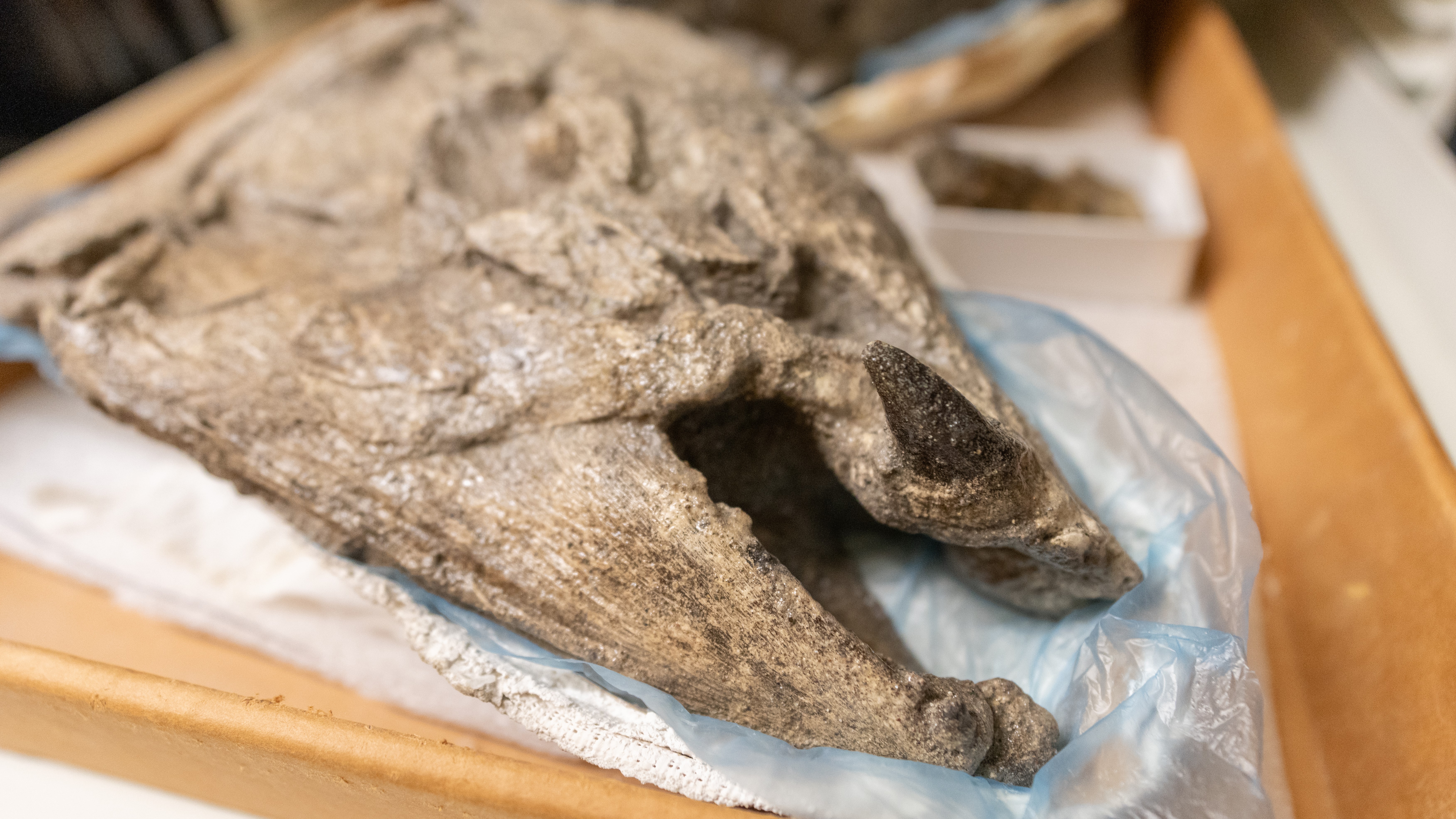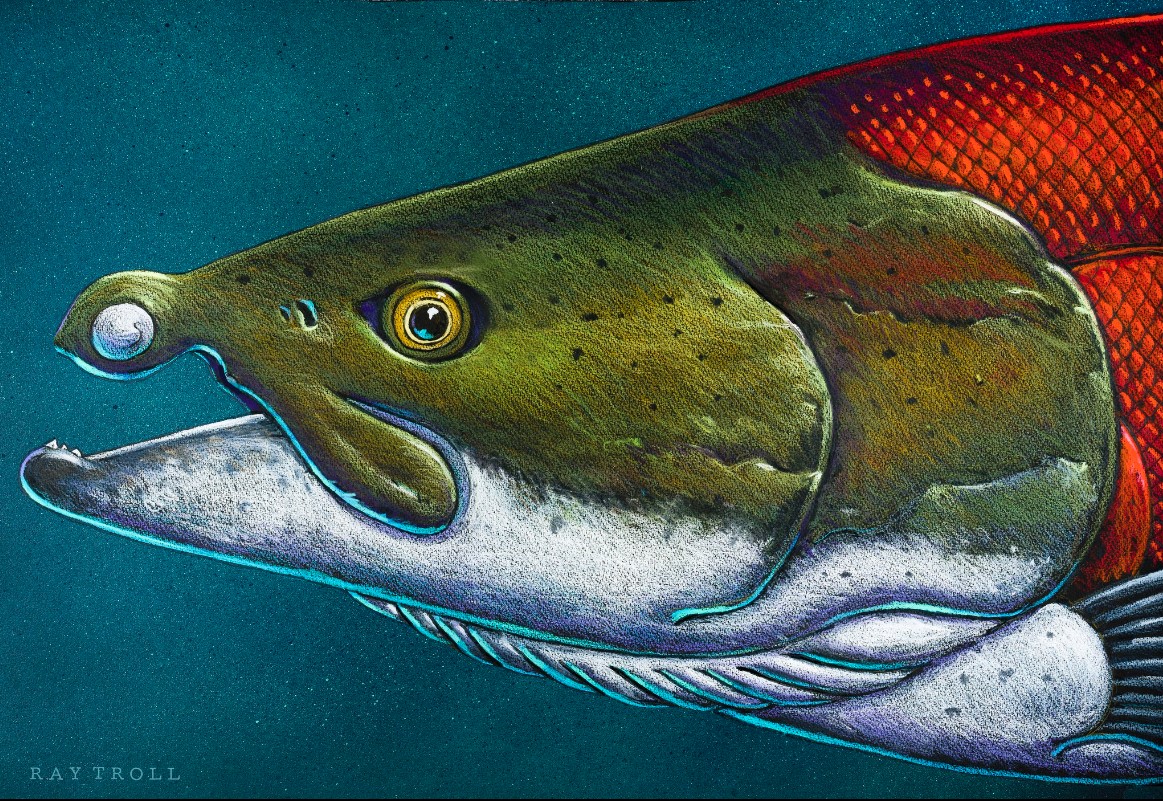
A massive prehistoric salmon had tusk-like teeth that protruded from either side of its snout, a new study finds.
Capable of reaching 8.8 feet (2.7 meters) in length by some estimations, Oncorhynchus rastrosus, a Pacific species, was the largest salmon ever known to live — over double the size of the largest Pacific salmon alive today, the Chinook salmon (Oncorhynchus tshawytscha), which typically grows to around three feet (0.9 meters) long.
Scientists have long been intrigued by O. rastrosus‘s exceptional teeth, a physical feature reflected in the anatomy of fossilized skulls. Initially, they thought the teeth curved downward like those of a saber-toothed cat, leading the common name of "saber-toothed salmon" to be bestowed upon the species.
However, a new study published Wednesday (April 24) in the journal PLOS One shows that the teeth more resembled a warthog's tusks, projecting sideways, not downward.
"[O. rastrosus had] these very unique features that don't exist everywhere else," study first author Kerin Claeson, professor of anatomy at the Philadelphia College of Osteopathic Medicine, told Live Science.
Related: Do elephant tusks or rhino horns ever grow back?
First described in the 1970s, O. rastrosus swam in what are now the waters of the Pacific Northwest. A 2016 paper on O. rastrosus reported that fossils date to between 12 and 5 million years ago.
O. rastrosus is a close relative — but not an ancestor — of modern Pacific salmon, especially the sockeye, according to Claeson.
Like modern Chinook salmon, Claeson said, O. rastrosus would have been born in freshwater rivers and streams but spent the majority of their lives out at sea, returning only to spawn (and likely die). But unlike Chinook salmon, whose diets primarily consist of other fish, these ancient fish were filter feeders that dined on plankton, sucking the microscopic creatures into their mouths through sieve-like gill rakers.
By around 4.75 million years ago, O. rastrosus had gone extinct, according to Claeson. The first fossils were collected in California and Oregon, but they were disarticulated, Claeson said, meaning the teeth had separated from the rest of the skull. With no visual means of identifying the position of the teeth in the skull, investigators, knowing that modern Pacific salmon have downward-facing teeth, inferred O. rastrosus did, too.

"It was just natural to assume that when you put this [tooth] back into place, that's the arrangement that it's going to be," Claeson said.
In the 2010s, scientists found evidence that challenged this assumption. During a 2014 expedition to the Gateway Quarry in Jefferson County, Oregon, crew members recovered additional O. rastrosus fossils, including the skulls of a male and female believed to have comprised a breeding pair, Claeson said. Both of these skulls differed from the early specimens in a key way: The bones of the jaw were still connected and the sideways orientation of the teeth was visually apparent.
When the skulls were first brought to Claeson's attention, she was thrown by their morphology and figured a fluke had occurred. But then, she said, "they found more."
CT (computed tomography) scans revealed specific features on the upper jaw that confirmed the teeth would have extended laterally away from the face — findings that indicate the original saber-toothed reconstruction of O. rastrosus had been flawed, according to the study. Based on this discovery, the researchers assert that O. rastrosus should be renamed the spike-toothed salmon.
Despite its large size, O. rastrosus was probably a target for contemporary carnivores, according to Claeson. An individual would have yielded "a lot of meat," she said. While the exact purpose of the teeth is not clear, they may have helped O. rastrosus defend against predators, compete with rivals and/or dig nests in the riverbed, according to the study. Claeson hopes to examine the teeth themselves for patterns of wear that could indicate what exactly they were used for.







